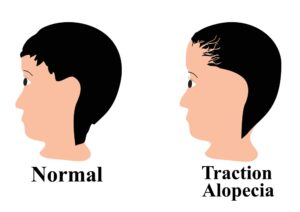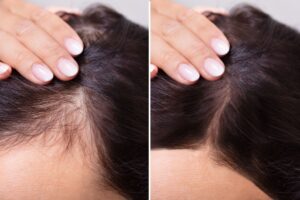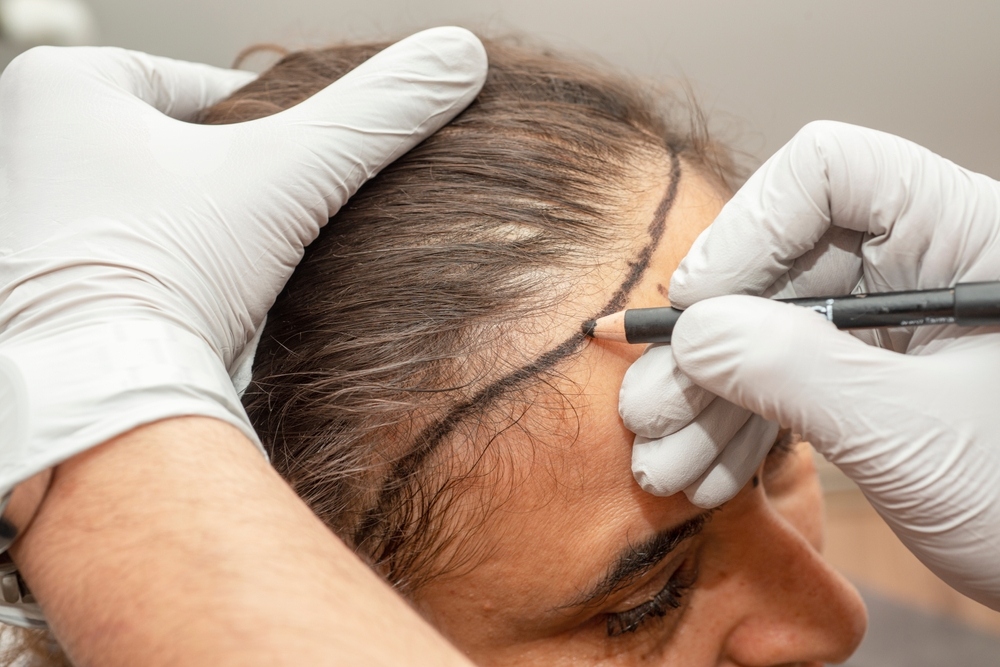One of the natural treatments accessible to patients suffering from hair loss is hair transplantation. People’s hair grows in a healthy way that improves their mood. Although it is not a long-term fix for thinning hair, it can help many people regain their confidence and hair fullness.
Hair transplantation utilises microsurgical techniques to transplant healthy hair follicles to regions where baldness is developing and the hair follicles are no longer active. The patient’s healthy hair is added to the damaged area throughout hair transplantation.
Women can shed their hair for a variety of reasons. But genetics can frequently be held responsible. Like their male counterparts, some women also have the hair loss gene, And while some people with the gene never experience hair loss, others experience it, like male pattern baldness.
Different Types of Hair Loss :
Female Pattern Hair Loss
The female pattern hair loss condition can cause significant thinning of hair, but it does not typically result in complete baldness. In women, thinning hair occurs all over the scalp throughout time, although the hairline does not typically go backward. This hair loss occurs naturally as a woman ages and is considered a normal component of the ageing process.
Traction Alopecia

It is conceivable for certain hairstyles, such as tight ponytails and braids, to pull hair away from the scalp with such force that individual hair strands become damaged and eventually fall out. Traction alopecia can potentially result in thinning hair or even bald spots if the hairstyle is not altered. After a change in hairstyle, your hair should regrow most of the time rapidly.
Traumatic Hair Loss

Even though a person’s hair may lose a significant amount, this is usually only temporary, and the hair will eventually regrow. Temporary hair loss, known as telogen effluvium, frequently follows stress, shock, or a traumatic experience. Usually, the top of the scalp is affected. Alopecia areata, a condition that leads to accelerated hair loss, is distinct from telogen effluvium.
What Causes Female Hair Loss?
- Nutritional deficiencies brought on by dietary modifications, eating disorders, or vitamin and mineral deficits. Malnutrition or an insufficient amount of vitamins in your body, such as a deficiency in vitamins D and B12, for example
- An imbalance in your hormone levels may occur during menopause if you are stressed.
- Trauma or stress brought on by medical procedures or emotional issues.
- Thyroid disorders and their accompanying treatments.
- Applying heat improperly or excessively, such as with straighteners and hair dryers, can cause hair damage.
- Traction alopecia is a condition that results from the hair being plucked out repeatedly.
- Postpartum and postmenopausal phases, ovarian tumours, and other obstetric and gynaecological diseases.
Types of hair transplants available for women:
FUE Hair Transplant

Awareness of every method offered when researching female hair treatment is vital. FUE hair transplants should be considered if you’re looking for a hair transplant process that will cause the least amount of interruption possible in the donor location.
It is when every individual hair is plucked from the donor area, leaving very little scarring or damage to the nearby hair. If you have long hair, it is the best alternative for minimising the appearance of the donor region because it is completely covered while the hair is still growing back.
FUT Hair Transplant

In the FUT method of hair transplantation, a strip of skin containing hair follicles is removed from the donor site, usually, the back of the head, where hair is thicker and less prone to balding naturally. Stereo-microscopic dissection is used to remove their hair from a strip of skin, albeit this generates more disruption to the scalp.
This technique for removing the donor’s hair is ideal for those with poor donor areas or hair types that can be challenging to work with. Although it is the more invasive approach, it is the best alternative to guarantee that the hair will survive and thrive for a long time.
Good Candidates of Hair Transplant for Women
Many women with broad hair loss are poor candidates for hair transplants since there aren’t enough donors to cover their backs, sides, or other body parts. However, there are specific circumstances in which a patient’s look can be considerably enhanced by hair transplantation in women:
- Women have experienced hair loss due to mechanical or traction alopecia (nonhormonal).
- Women who have already undergone cosmetic or plastic surgery are concerned about hair loss at the incision sites.
- Women experience baldness that maintains a distinct pattern, similar to male baldness. It encompasses a donor area unaffected by androgenetic alopecia, vertex thinning (on the crown or top of the scalp), and hairline recession.
- Women who have hair loss as a consequence of trauma, including burn victims, accident scarring, and chemical burns.
- Women who already have traction alopecia, a condition that resembles alopecia.
Benefits of Hair Implants Surgery
One of the long-term solutions for replacing lost hair is hair transplantation. For those with profound baldness, it is the finest method of treatment. The following are a few advantages of hair transplant surgery:
Natural Looking Hairline
The procedure of air transplantation is perfectly secure and organic. There are no chemicals or drugs utilised that could harm your hair. A hair transplant is a perfectly natural procedure because the outcomes allow for a hairline that looks more natural. You can anticipate long-lasting impacts and a gorgeous, healthy head of hair.
Removes Baldness
A hair transplant will alleviate hair-related concerns. A hair transplant works to reshape your receding hairline and strengthens the hair volume on balding or thinning regions of your head. You won’t likely experience balding again because of the highly effective results of a hair transplant.
Enhances your self-confidence and appearance
People frequently develop emotional attachments to their hair because our sense of style and self-image are closely tied to how our hair looks. Early hair loss sufferers have higher levels of self-consciousness about their appearance. Due to hair loss, you could have a sense of loss, a lack of confidence, and a reduction in your self-esteem.
Hair loss influences our personal and professional lives physically and emotionally. Hair transplant surgery can enhance confidence and self-esteem. You’ll look and feel better due to your lovely, brand-new full head of hair.
Cost-effectiveness
It can be a little pricey because it is a long-term fix. Since the operation is one-time, you won’t have to pay for subsequent or routine appointments. However, the price may differ from person to person based on the region, the expertise and experience of the surgeon, the technique is chosen, and other considerations.
Prevention for Hair Loss in Women?
A good diet, self-care practices, and medical interventions can deter hair loss. Understanding the type of hair loss experienced by women and its reasons is vital before proposing any treatment plans. This only works when a qualified surgeon makes the proper diagnosis. It will also be simpler to determine the patient’s most effective treatment strategy if it is known whether the hair loss condition is permanent or temporary, progressive or stable.
Are Transplants for Women Different from Transplants for Men?
Female organ transplants are identical to male transplants, despite being a little more recent and thus more common. Hair transplants are more challenging for women since their balding areas have healthier hair than men. Doctors are more aware of the potential impacts that female physiology may have on hair growth and transplant recovery.
The doctor doing the procedure must be more cautious when placing the transplants to prevent damage to the patient’s natural hair. Female androgenic alopecia may initially affect only a few spots on your scalp. But over time, the entire scalp may begin to be affected. You will gain a lot by managing the matter correctly and always arriving at a better conclusion. All you have to do to get the best results is handle it correctly.
FAQ?
A hair transplant: Is it worthwhile?
Hair transplants are unquestionably worthwhile when you consider the impacts on confidence, appearance, and the long-lasting nature of the treatment. Then, we might think about how much of an impact it will have on our lives, how long it will take to recover, and what the final result will be.
How unpleasant is a hair transplant procedure?
No, a hair transplant is not painful because of local anaesthetic and post-operative pain relievers. A hair transplant is often a pleasant and straightforward experience for most people experiencing hair loss, even though no procedure can be entirely painless, and some brief and probably transitory level of discomfort is conceivable.
How long does a hair transplant for women last?
Because healthy hair follicles are transplanted into bald or thinning areas, hair transplants typically last a lifetime. Before you notice any substantial improvements in hair growth, it usually takes six months. After a year, the full effects of the transplant will become apparent.
How well do women’s hair transplants work?
The condition of the recipient’s scalp is the primary indicator of whether a transplanted growth will be successful. In scar tissue, hair transplants will grow, but the chances of it happening are between 50% and 70%, as opposed to at least 95% on a healthy scalp.
How will I know whether or not my hair transplant was successful?
The transplanted hair frequently starts falling out after a few weeks and then begins to grow back. New hair will generally start to grow in and after six months. The entire set of results should be seen after 12 to 18 months.
Conclusion:
Hair transplantation is a difficult technique. The excellent thing is that hair loss is not something you have to suffer. A hair transplant can give women a fuller, more realistic-looking hairline with no noticeable scarring and a speedy recovery. Before planning to undergo hair transplant treatment, consult with your surgeon.


